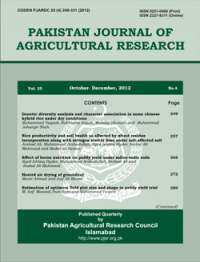YIELD GAP DETERMINANTS FOR WHEAT PRODUCTION IN MAJOR IRRIGATED CROPPING ZONES OF PUNJAB, PAKISTAN
Abid Hussain*, Khalid Mahmood Aujla* and Nouman Badar*
ABSTRACT
Yield gap is useful measurement for crop productivity and the extent to which crop productivity falls below some potential level. The study was carried out to analyze the yield gap and determinants of wheat production in the Punjab province of Pakistan. It is based on cross sectional data from 210 farmers for the crop year 2009-10. Results suggest that farm level wheat yields are less than the potential yield level by 33.0%, 43.0% and 50.6% in the mixed-cropping, cotton-wheat and rice-wheat zones of the province, respectively. Ordinary least square regression analysis of wheat production by assuming Cobb-Douglas specification reveals that the number of irrigations, usage of farm yard manure and fertilizers contribute positively and significantly to wheat crop production. Coefficients of dummy variables for cropping zones indicate that farmers in the mixed cropping zone are obtaining better yield of the wheat crop as compared to their counterparts in other selected cropping zones. These results suggested that farmers can increase wheat productivity by increasing the use of factor inputs; however, poverty may be a constraint on realizing these gains. Thus, wheat production can be increased in the country by helping resource poor farmers through suitable support mechanisms.
To share on other social networks, click on any share button. What are these?






